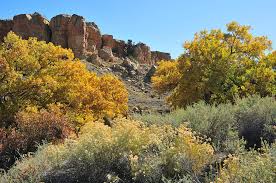celebrating the desert
 I’ve called New Mexico home for close to 14 years. The first time I visited the southwest, I was smitten with the wide-open skies, the abundant and ever-changing light, and the subtleties of the desert landscape. I even liked the heat.
I’ve called New Mexico home for close to 14 years. The first time I visited the southwest, I was smitten with the wide-open skies, the abundant and ever-changing light, and the subtleties of the desert landscape. I even liked the heat.
The beautiful description of the desert that follows is courtesy of my friend Bob Walling, who—in addition to being a very fine writer—is also a former corporate trainer, university lecturer and British travel professional. Thank you, Bob.
April 2015
Chamisa, sage, Morman tea, rabbitbush, broombush, desert rose, paintbush, cholla, prickly pear, scruboak are names to be spoken gently in this land of wind. These inhabitants of the desert enter the eye as quietly and gently as a Navajo person entering a room. Like the Navajo entering they seek harmony with their surroundings without disturbing the air. These plants take little from the land but without adding the silver of the sage, orange-red of the paintbrush or the white of the desert rose the painter’s palette would have missed the honest colors of the desert.
The words buttes, canyons, arroyos, and barrancas, stand as linguistic witnesses to the parade of visitors to this space during the last 400 years. Modern man’s attempt to give names in his language to the violent evidence of a land in turmoil– land of volcanoes, eruptions and earthquakes. Travelers driving, travelers towing silver bullets, travelers pulling Winnebagos nearly as large as some of the villages they are named after pass down the road, and travelers with their life’s belongings stowed in the back seat traveling 75 miles an hour gawk sideways at the evidence of this geologic violence and hurry through as if the violence might be latent and intent on occurring again. The desert, as it appears at this speed looks like a colorful crime scene of scattered eruptions, deep cuts running blood red and jagged evidence of an angry god. Older people seem to be drawn to drive across the landscape, silent observers in metal boxes to this violence thrilling the eye with color as they once thrilled the body on a rollercoaster.
 It gives up only the obvious to these visitors in its colors of reds, oranges and browns and keeps concealed the silvers, chartreuses and greens which it keeps tucked close to the land. The rushing motorists soak the eyes with colors already obtained from National Geographic. The sun bleaches the landscape to a one dimensional panorama. The language of the desert is subtle not read easily by the person passing hurriedly to some unknown destination. The desert speaks in profiles at sunrise and shadows at sunset and the barking howl of the coyote when least expected. The coyote speaks like a desert wind, first barking like a dog and then breaking into a lonely howl which causes a tiny shiver of melancholy in us the lonely audience. The coyote is the loon of the desert, looking like a dog at a distance, just as a loon looks like a duck at a distance. It is in their calls that both establish their lonely independence.
It gives up only the obvious to these visitors in its colors of reds, oranges and browns and keeps concealed the silvers, chartreuses and greens which it keeps tucked close to the land. The rushing motorists soak the eyes with colors already obtained from National Geographic. The sun bleaches the landscape to a one dimensional panorama. The language of the desert is subtle not read easily by the person passing hurriedly to some unknown destination. The desert speaks in profiles at sunrise and shadows at sunset and the barking howl of the coyote when least expected. The coyote speaks like a desert wind, first barking like a dog and then breaking into a lonely howl which causes a tiny shiver of melancholy in us the lonely audience. The coyote is the loon of the desert, looking like a dog at a distance, just as a loon looks like a duck at a distance. It is in their calls that both establish their lonely independence.
The wind is the storyteller of the desert. The wind wraps you up in a constant conversation, sometimes gently nudging you to think about yourself here and sometimes violently telling its story with wild gusts that kick up foreign thistles across the road. Visitors huddle from the wind when it gusts, make way quickly to their cars and take flight as if the wind’s story is too harsh a tale to be heard by gentle folk. It is the wind that tells us the story of the buttes, sings songs that are deep inside us and gestures with wind language to tell us where best to walk.
Many visitors come here to find purity in a world become too complex at home. Here they hope the colors are true and primeval, but the desert is the world and it is complex. The desert is a multi-cultural experience composed of the tracks left by people and animals that weren’t there four hundred years ago like the tumbleweed from the British Isles, the Russian Olive from Europe, the sheep, horses, and cows from Spain, and the river bed of a canyon yielding the spring buds of the tamarisk. Only the orange of the buttes is native and original here.
This post is part of April’s 30 Days of Celebration. To read more, click on the Celebration category link.












